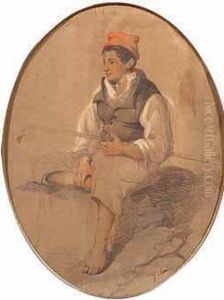Carelli Gabriele Paintings
Gabriele Carelli was an Italian painter born in 1820 in Naples, Italy, into a family deeply rooted in the arts. His father, Raffaele Carelli, was a well-respected landscape painter, ensuring that Gabriele was immersed in the world of art from a young age. Under the guidance of his father and amidst the rich cultural backdrop of Naples, Gabriele developed a keen interest in landscape painting, a genre that would define his career.
Carelli's early years were marked by extensive travel throughout Europe, particularly in England, where he received commissions from the British aristocracy, and in France, where he was influenced by the Barbizon school's approach to landscape painting. These experiences broadened his artistic horizons and infused his work with a blend of Italian romanticism and European realism. His landscapes are characterized by meticulous attention to detail, vibrant use of color, and a deep appreciation for the natural world, qualities that made his work sought after by collectors and critics alike.
In the mid-19th century, Carelli became part of the Etruscan School, a group of artists who were inspired by the Italian countryside, particularly the regions of Tuscany and Umbria. This period saw him exploring new subjects and refining his technique, leading to works that combined his love for Italian landscapes with a more nuanced understanding of light and atmosphere. Despite the influence of contemporary artistic movements, Carelli's style remained distinctively his own, bridging the gap between the classical and the modern.
Gabriele Carelli's contributions to Italian art were not limited to his paintings. He was also a mentor to younger artists and played a significant role in the cultural life of Naples and beyond. Throughout his career, he exhibited widely, including at the Royal Academy in London, where his works were met with acclaim. His paintings are now part of several major collections, including those of the British Royal Family, a testament to his enduring appeal and the universal quality of his art.
Carelli died in 1900, leaving behind a legacy that has continued to influence landscape painting in Italy and around the world. His dedication to capturing the beauty of the natural world, combined with a masterful technique, ensures that Gabriele Carelli remains a significant figure in the history of 19th-century European art.
